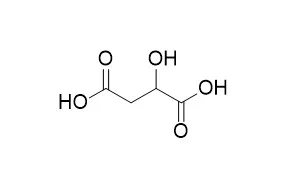| Animal Research: |
| Journal of Animal ence(3):1048-1057. | | Effect of DL-malic acid supplementation on feed intake, methane emission, and rumen fermentation in beef cattle.[Reference: WebLink] | The objective of this study was to determine the effect of dietary concentration of DL-Malic acid (MA) on DMI, CH(4) emission, and rumen fermentation in beef cattle.
METHODS AND RESULTS:
Two Latin square experiments were conducted. In Exp. 1, six beef heifers (19 +/- 1 mo old) were assigned in a duplicated Latin square to 1 of 3 dietary concentrations of MA on a DMI basis (0%, MA-0; 3.75%, MA-3.75; or 7.5%, MA-7.5) over 3 periods. In Exp. 2, four rumen-fistulated steers (48 +/- 1 mo old) were assigned to 1 of 4 dietary concentrations of MA (0%, MA-0; 2.5%, MA-2.5; 5.0%, MA-5.0; or 7.5%, MA-7.5) on a DMI basis, over 4 periods. Both experimental diets consisted of grass silage and pelleted concentrate (containing MA). Silage was fed ad libitum once daily (a.m.), whereas concentrate was fed twice daily (a.m. and p.m.) with the aim of achieving a total DMI of 40:60 silage:concentrate. In both Exp. 1 and 2, experimental periods consisted of 28 d, incorporating a 13-d acclimatization, a 5-d measurement period, and a 10-d washout period. In Exp. 1, enteric CH(4), feed apparent digestibility, and feed intake were measured over the 5-d measurement period. In Exp. 2, rumen fluid was collected on d 16 to 18, immediately before (a.m.) feeding and 2, 4, 6, and 8 h thereafter. Rumen pH was determined and samples were taken for protozoa count, VFA, and ammonia analysis.
Enteric CH(4) emissions were estimated by using the sulfur hexafluoride tracer technique and feed apparent digestibility was estimated by using chromic oxide as an external marker for fecal output.
CONCLUSIONS:
In Exp. 1, increasing dietary MA led to a linear decrease in total DMI (P < 0.001) and total daily CH(4) emissions (P < 0.001). Compared with the control diet, the greatest concentration of MA decreased total daily CH(4) emissions by 16%, which corresponded to a 9% reduction per unit of DMI. Similarly, in Exp. 2, inclusion of MA reduced DMI in a linear (P = 0.002) and quadratic (P < 0.001) fashion. Increasing dietary MA led to a linear decrease in molar proportion of acetic (P = 0.004) and butyric acids (P < 0.001) and an increase in propionic acid (P < 0.001). Ruminal pH tended to increase (P = 0.10) with increasing dietary MA. Dietary inclusion of MA led to a linear (P = 0.01) decrease in protozoa numbers. Increasing supplementation with MA decreased CH(4) emissions, but DMI was also decreased, which could have potentially negative effects on animal performance. |
|
| Structure Identification: |
| JOURNAL OF INSTRUMENTAL ANALYSIS, 1999. | | Determination of DL-Malic Acid by Potassium Permanganate Chemiluminescence System.[Reference: WebLink] |
METHODS AND RESULTS:
A new detection method for DL-Malic acid was established based on the chemiluminescence of potassium permanganate in sulfuric acid solution. It has a linear response range of 1.0×10-6~1.0×10-2 mol·L-1 and a detection limit of 1.0×10-9 mol·L-1 for DL-Malic acid. Parallel analysis of samples with a certain concentration showed RSD of 1.4%(n=8). Good results for determination of real samples of apple juice and drink are obtained by this method.
CONCLUSIONS:
Due to its good reproducibility, simplicity and sensitivity, this method has broad prospects of application. Mechanism of chemiluminescence and self _ catalytic attribute of this system were briefly discussed. |
|






 Cell. 2018 Jan 11;172(1-2):249-261.e12. doi: 10.1016/j.cell.2017.12.019.IF=36.216(2019)
Cell. 2018 Jan 11;172(1-2):249-261.e12. doi: 10.1016/j.cell.2017.12.019.IF=36.216(2019) Cell Metab. 2020 Mar 3;31(3):534-548.e5. doi: 10.1016/j.cmet.2020.01.002.IF=22.415(2019)
Cell Metab. 2020 Mar 3;31(3):534-548.e5. doi: 10.1016/j.cmet.2020.01.002.IF=22.415(2019) Mol Cell. 2017 Nov 16;68(4):673-685.e6. doi: 10.1016/j.molcel.2017.10.022.IF=14.548(2019)
Mol Cell. 2017 Nov 16;68(4):673-685.e6. doi: 10.1016/j.molcel.2017.10.022.IF=14.548(2019)